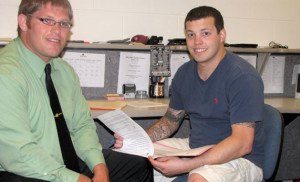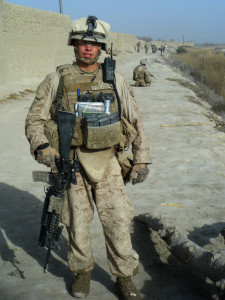Today’s veterans need a place to turn
Crossing the Atlantic after his days in the infantry and military police battalion were over, World War II veteran Ronald M. Peterson had “a really good feeling†about the war being over.

At SDSU, Aaron Delzer, right, came in contact with ex-Marine Brian Mahaffey, coordinator of veteran affairs. Delzer says Mahaffy helped him adjust to civilian life.
The ship carrying him and other soon-to-be ex-servicemen landed near New York City. About a day later, his unit was on the train to Camp McCoy, Wis. Two days later the Army said that you’re now a civilian.
Peterson got on the train to the Twin Cities and took a bus to his home in Brookings the next day.
“Suddenly being a civilian was a shock. Suddenly everything is on your own,†Peterson says. “I remember being on the train thinking ‘Now I can do what I wish.’ It was just a very strange feeling.â€
Strange, but not unique.
Peterson was among millions who returned to America after the country found victory in Germany and Japan.
For a great many of them, civilian life meant student life as they took advantage of the GI Bill, which was passed by Congress in 1944. The bill paid for tuition and $50 per month living expenses. As a result, veterans accounted for 49 percent of college admissions by 1947.
Whereas 16 million Americans served in World War II, the numbers were much smaller and the withdrawal more gradual for servicemen returning from recent duty in Iraq and Afghanistan.
Peterson, who attended State from 1940 to 1943 and then finished his degree at Colorado State University, says, “a good share of your classmates were veterans.â€
Different story today
But Aaron Delzer, who served in Afghanistan, and Brian Mahaffy, who served in Iraq, didn’t have that type of camaraderie when they enrolled at SDSU.
“It has definitely been a challenge adjusting to campus culture. I was so used to having an organized schedule. Now it is all up to me on what I want to do and how I want to spend my time,†says Delzer, who enrolled in fall 2012 after four years in the Marine Corps infantry.
“It was frustrating not knowing where everything was located on campus at first,†the Groton native adds.

Aaron Delzer, who served in the infantry with the Marines, spent seven months in Afghanistan. He is shown here on the Patriots route, an area where the Marines had come in contact with a lot of homemade bombs and firefights with Taliban fighters.
He did know where to go to see Mahaffy, SDSU’s first coordinator of veterans affairs.
Mahaffy was hired in June 2012 and has a story similar to Delzer. “It was a hard transition, not having anyone to go to,†Mahaffy says. He went into Marine Corps boot camp in September 1999 and was discharged as a platoon sergeant in August 2003.
Connecting with other vets
The Sturgis native was out in time to enroll for classes at State for fall 2003 and made the library his foxhole.
“There was amazing camaraderie in the (Marine) units you were in. If you went into town, you knew someone had your back,†says Mahaffy, who spent seven months in Iraq in 2003. “In civilian life, you just couldn’t connect. I spent the first two years in the library studying.
“You lose that sense of mission and meaning†that is presented in the Marines, he says.
Mahaffy finally did connect when he met another veteran who was a member of Delta Chi fraternity.
He accepted an offer to join Delta Chi in the spring of his sophomore year and found the group had five members who were veterans. That experience helped him get through college, earning a psychology degree in 2007, but he didn’t land a job until 2009.
While looking for work, he served as a volunteer with the veterans resource center at the University of South Dakota in Vermillion.
“I enjoyed connecting with vets,†Mahaffy says. He worked as a counselor at the Human Services Center in Yankton from 2009 to 2011.
Armed Forces group aids cause
When SDSU created the position of coordinator of veterans affairs, Mahaffy knew it was a perfect fit for his education, experience and passion. He realizes he can be a lifeline for veterans.
“Having at least one person who knows what I’ve been through, that means a lot,†he says.
Delzer agrees. He thanks Mahaffy for introducing him to the Armed Forces Association, which is a campus group of veterans, service members and dependents of veterans. “Talking with them broadened my friend base. For the most part I was on my own before that organization,†Delzer says.
The association, which meets the second and fourth Wednesdays at the Brookings VFW, has 20-plus active members.
During the school year, the group made monthly visits to the VA Hospital in Sioux Falls to serve pizza to veterans of all ages—from World War II vets to those of the current Mideast conflict. For the Hobo Day parade, they made a battleship float.
Delzer says, “When I joined, I once again felt like I was in a brotherhood that had been void since leaving the Marines.â€
There wasn’t an Armed Forces Association when Mahaffy went to State, nor were there orientation sessions for veterans during new student orientation. “There wasn’t even talk of a veterans orientation when I came through,†he says.
This summer Mahaffy gave a one-hour presentation during each of the nine orientation sessions.
Serving current service members
His duties also include being an advocate for active service members who are taking online classes through SDSU. One such person is Thomas Beck, a law enforcement officer in the 79th Military Police Company, an Army Reserve unit out of Rochester, Minn.
The history major enrolled at State in fall 2008 and enlisted in the Reserves the following year.
He missed a semester for advanced infantry training and another semester for additional training, but when he was deployed to Kuwait in June 2012 he began taking online classes. The Tri-Valley High School grad has taken six credits per semester and took one class this summer.
Overall, it has been a good experience. “He’s been getting As and Bs,†says his mom, Ginny Beck of Crooks.
“However, there was an instructor who gave him no leeway in turning in papers and projects late due to his duties in the Army,†she says. “By midterm, Tom feared for the worse, that he was failing a class. It wasn’t that he wasn’t doing the work. It was because the work he did was turned in late due to Army missions.
“That is when we turned to the veterans affairs office at SDSU. I spoke with Brian. Tom communicated to him as well via Internet.
“We explained the situation that was unfolding in front of Tom with the prospect of failing a class. Brian came forward on our son’s behalf and spoke with the dean and, luckily, Tom ended up with a “C†as a final grade in this particular class.â€
Beck, now deployed to protective service detail in Jordan, continues to take online classes at State.
New degree tailored to military
Mahaffy’s work is part of the reason that SDSU has been designated as a military friendly school by Victory Media.
Also, in spring semester a new online master’s degree program was started that is tailored to veterans, service members and their families. The degree in human sciences specializes in family and community services, according to creator AnnMichelle Daniels.
In developing the degree, Daniels did research at Fort Briggs and Fort Leavenworth, and spent time with actual military families.
Daniels says, “In my current life span development class, I have four that are in the military, four military spouses and two members of the general public. I ask how this theory would apply to military families whose children move frequently.
“We try to tailor it to what they’re going through. It gives them the theory to accompany their experiences.â€
‘Heart and Fist’ author coming
This year the university’s commitment to veterans extends to its Common Read project. All freshmen as well as many other classes are required to read “The Heart and the Fist,†a story of the leadership and service performed by its author, Eric Greitens, a former Navy SEAL.
Greitens will speak at the Performing Arts Center at 7 p.m. Nov. 13 and Mahaffy plans to take a group of veterans with him.
Dave Graves






